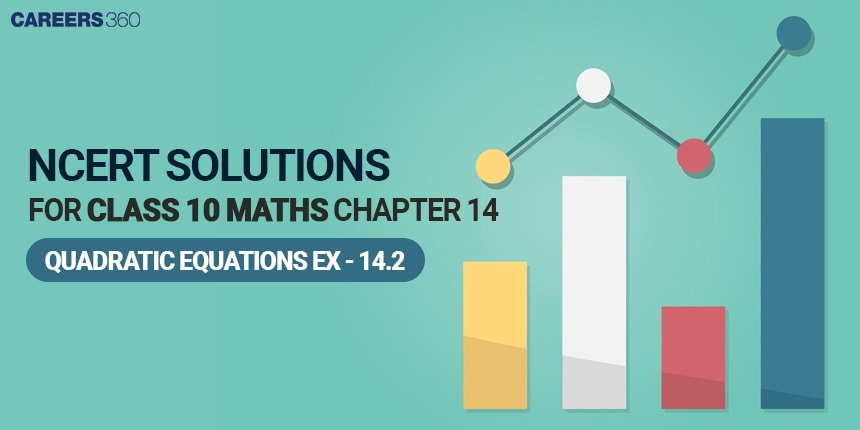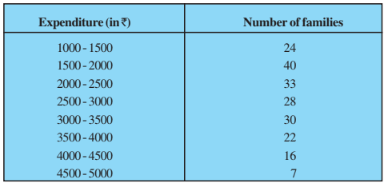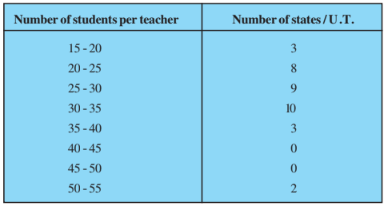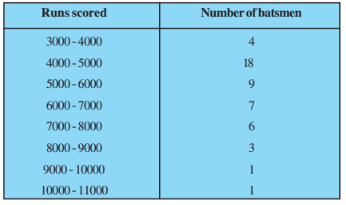NCERT Solutions for Exercise 14.2 Class 10 Maths Chapter 14 - Statistics
CBSE Class 10th Exam Date:01 Jan' 26 - 14 Feb' 26
Knowledge about data patterns in grouped data formats enables better interpretation of real-world trends in the data. This part of the chapter explores mode as a central tendency measure used to determine the most recurrent value in a dataset. The mode is crucial in statistical assessment, especially when data exists in interval groups. We evaluate patterns in the most recurring data points by utilising graphical and algebraic tools in this research. This exercise demonstrates to students how to calculate the mode for grouped data by using an appropriate formula.
This Story also Contains
- NCERT Solutions Class 10 Maths Chapter 13 Exercise 13.2
- Assess NCERT Solutions for Class 10 Maths Chapter 13 Exercise 13.2
- Topics Covered in Chapter 13 Statistics: Exercise 13.2
- NCERT Solutions for Class 10 Subject Wise
- NCERT Exemplar Solutions of Class 10 Subject Wise

The NCERT Solutions featured here apply to the latest version of National Council of Educational Research and Training books from the 2025–2026 school year. The solutions guide students to break down the procedure of locating the modal class, then use the proper formula to find the mode. Knowledge mastery of this topic enables students to apply their learned skills in economic research and healthcare, and social science investigations because they need to find and understand dominant patterns. The exercise functions as an essential tool for solidifying the knowledge described in NCERT Books.
Assess NCERT Solutions for Class 10 Maths Chapter 13 Exercise 13.2
Q1 The following table shows the ages of the patients admitted in a hospital during a year:

Find the mode and the mean of the data given above. Compare and interpret the two measures of central tendency.
Answer:
To find the modal class: The class having the maximum frequency is the modal class. And, the maximum frequency is 23, and hence the modal class = 35-45
Thus, Lower limit (l) of modal class = 35, class size (h) = 10
Frequency (
Frequency (
Frequency (
Therefore,
Now,
Age | Number of patients | Classmark | |
5-15 | 6 | 10 | 60 |
15-25 | 11 | 20 | 220 |
25-35 | 21 | 30 | 630 |
35-45 | 23 | 40 | 920 |
45-55 | 14 | 50 | 700 |
55-65 | 5 | 60 | 300 |
=80 | =2830 |
Mean,
Therefore, the maximum number of patients is in the age group of 36.8, whereas the average age of all the patients is 35.37.

Determine the modal lifetimes of the components.
Answer:
To find the modal class: The class having the maximum frequency is the modal class. And, the maximum frequency is 61, and hence the modal class = 60-80
Thus, Lower limit (l) of modal class = 60, class size (h) = 20
Frequency (
Frequency (
Frequency (
Therefore,
Thus, the modal lifetime of 225 electrical components is 65.62 hours

Answer:
To find the modal class: The class having the maximum frequency is the modal class. And, the maximum frequency is 40, and hence the modal class = 1500-2000
Thus, Lower limit (l) of modal class = 1500, class size (h) = 500
Frequency (
Frequency (
Frequency (
Therefore,
Thus, the Mode of the data is Rs. 1847.82
Now,
Let the assumed mean be a = 2750 and h = 500
Expenditure | Number of families | Classmark | | | |
1000-1500 | 24 | 1250 | -1500 | -3 | -72 |
1500-2000 | 40 | 1750 | -1000 | -2 | -80 |
2000-2500 | 33 | 2250 | -500 | -1 | -33 |
2500-3000 | 28 | 2750 | 0 | 0 | 0 |
3000-3500 | 30 | 3250 | 500 | 1 | 30 |
3500-4000 | 22 | 3750 | 1000 | 2 | 44 |
4000-4500 | 16 | 4250 | 1500 | 3 | 48 |
4500-5000 | 7 | 4750 | 2000 | 4 | 28 |
=200 | = -35 |
Mean,
Thus, the Mean monthly expenditure is Rs. 2662.50

Answer:
To find the modal class: The class having the maximum frequency is the modal class. And, the maximum frequency is 10, and hence the modal class = 30-35
Lower limit (l) of modal class = 30, class size (h) = 5
Frequency (
Frequency (
Frequency (
Therefore,
Thus, the Mode of the data is 30.625
Now,
Let the assumed mean be a = 32.5 and h = 5
Class | Number of states | Classmark | | | |
15-20 | 3 | 17.5 | -15 | -3 | -9 |
20-25 | 8 | 22.5 | -10 | -2 | -16 |
25-30 | 9 | 27.5 | -5 | -1 | -9 |
30-35 | 10 | 32.5 | 0 | 0 | 0 |
35-40 | 3 | 37.5 | 5 | 1 | 3 |
40-45 | 0 | 42.5 | 10 | 2 | 0 |
45-50 | 0 | 47.5 | 15 | 3 | 0 |
50-55 | 2 | 52.5 | 20 | 4 | 8 |
=35 | = -23 |
Mean,
Thus, the Mean of the data is 29.22
Find the mode of the data.
Answer:
To find the modal class: The class having the maximum frequency is the modal class. And, the maximum frequency is 18, and hence the modal class = 4000-5000
Lower limit (l) of modal class = 4000, class size (h) = 1000
Frequency (
Frequency (
Frequency (
Therefore,
Thus, the Mode of the data is 4608.70

Answer:
To find the modal class: The class having the maximum frequency is the modal class. And, the maximum frequency is 20, and hence the modal class = 40-50
Lower limit (l) of modal class = 40, class size (h) = 10
Frequency (
Frequency (
Frequency (
Therefore,
Thus, the Mode of the data is 44.70
Also Read-
Topics Covered in Chapter 13 Statistics: Exercise 13.2
1. Understanding Mode for Grouped Data: Learning Mode for Grouped Data shows how this statistical value represents the dominant entry, which occurs most often, especially when data is grouped into intervals.
2. Identifying the Modal Class: A practical method to discover the Modal Class describes the procedure for identifying the class interval with maximum frequency, as it serves as the foundation for calculating the mode.
3. Applying the Mode Formula: Statistical calculation of mode requires the lower class limit of the modal interval alongside the interval width and counts from the modal group, together with adjacent classes.
4. Solving Real-Life Based Word Problems: Students will solve real-life based word problems using frequency tables that originate from survey results or performance scores to establish the most common outcome.
5. Interpreting Data Trends: Those who master the ability to examine organised frequency distributions can form substantial conclusions from original data patterns.
Check Out-
NCERT Solutions for Class 10 Subject Wise
Students must check the NCERT solutions for class 10 of the Mathematics and Science Subjects.
NCERT Exemplar Solutions of Class 10 Subject Wise
Students must check the NCERT Exemplar solutions for class 10 of the Mathematics and Science Subjects.
Frequently Asked Questions (FAQs)
These concepts are discussed in 10th class maths exercise 14.2 answers. Modal class is the class which have maximum frequency or we can say that the class which has highest occurring value in the data. Practice these problems to command the concepts.
l = modal class's lowest limit
h = denotes the length of the class interval (assuming all class sizes to be equal)
f ₁ =represents the frequency of the modal class
f ₀ =represents the frequency of the class preceding the modal class
f ₂ = represents the frequency of the class following the modal class.
There are six questions in class 10 ex 14.2. Practice these problems to command the concepts.
There are three problems based on the nature of root that are solved before the Class 10 Mathematics chapter 14 exercise 14.2.
This ex 14.2 class 10 discuss about the concept of Central tendency refers to the centre value of all observations.
These concepts are discussed ex 14.2 class 10 comprehensively. With the help of mode , median and mean we can measure central tendency of a data. Practice this exercise to command these concepts.
These concepts are discussed in class 10 maths ex 14.2 . The data which have more than one value which are repeated in same frequency are called multimodal data. Practice the problems to command these concepts.
Questions related to CBSE Class 10th
On Question asked by student community
The CBSE Sahodaya Question Papers for Class 10 (2025-26) are not released centrally by the board as a single PDF.
Here is the essential information you need:
-
Local Release: The papers are designed and released by the individual Sahodaya School Clusters (groups of CBSE schools) just before or during the pre-board exam dates (typically held in December and January). Therefore, you must check your local cluster's portal or directly with your school administration.
-
Best Practice: The official model papers, based on the full 2026 syllabus, are the most reliable tool for practice. These accurately reflect the structure, format, and competency-based questions used in the Sahodaya exams.
You can download the latest CBSE Class 10 Model Papers to simulate the Sahodaya tests here: https://school.careers360.com/articles/sahodaya-question-paper-2025 . Focus on that pattern
Hi! If you’re looking for the Class 11 English half yearly question paper for 2025-26 (CBSE board), you’ll find the right resource once you check the link provided from Careers360. Solving previous or sample papers is a smart way to prepare, as it helps you understand the question types, marking scheme, and important topics. This practice will boost your confidence and help you manage your time well in the actual exam.
https://school.careers360.com/boards/cbse/cbse-class-11-half-yearly-sample-papers-2025-26
Hi dear candidate,
Could you please specify us the board of education for which you need the half yearly question papers of class X so that we can help you further.
Below are few links which may help you and it has all the subjects with English as well:
CBSE Class 10 Half Yearly Exam Question Paper 2025-26 with Answer Key & Analysis
ICSE Class 10 Half Yearly Sample Papers 2025-26 PDF (All Subjects)
BEST REGARDS
Hi dear candidate,
Can you please specify the board of education or state for which you need to know the exam pattern and syllabus so that we can guide you accordingly.
Since, most of the boards uses NCERT as base syllabus, you can refer to the link below:
NCERT Syllabus for Class 10 – All Subjects PDF Download 2025-26
Exam pattern:
CBSE 10th New Exam Pattern 2026- Marking Scheme, Subject-Wise Exam Pattern
BEST REGARDS
The CBSE Class 10th Board Exams for the 2026 session will follow the revised curriculum, emphasizing competency-based questions.
-
Conducting Body: Central Board of Secondary Education (CBSE).
-
Exam Period: The main theory exams are typically held between February and April 2026.
-
Grading: Based on marks in five main subjects plus internal assessment marks (often 20 marks per subject) provided by the school.
-
Passing Criteria: You must achieve at least 33% overall in each subject (theory + practical/internal assessment combined) to be declared pass.
Key Preparation Strategy
The most crucial element of your preparation is understanding the exam structure:
-
Syllabus: Strictly adhere to the rationalized syllabus released by CBSE for the 2025-26 academic year.
-
Practice: Your primary resource should be the latest sample papers and previous year question papers. These accurately reflect the format and types of competency questions being asked.
For the most comprehensive and official announcements, including the detailed time table and access to crucial practice materials, always check the official board updates, as tracked by Careers360: https://school.careers360.com/exams/cbse-class-10th .
Applications for Admissions are open.
As per latest syllabus. Physics formulas, equations, & laws of class 11 & 12th chapters
JEE Main Important Chemistry formulas
Get nowAs per latest syllabus. Chemistry formulas, equations, & laws of class 11 & 12th chapters
JEE Main high scoring chapters and topics
Get nowAs per latest 2024 syllabus. Study 40% syllabus and score upto 100% marks in JEE
JEE Main Important Mathematics Formulas
Get nowAs per latest syllabus. Maths formulas, equations, & theorems of class 11 & 12th chapters

